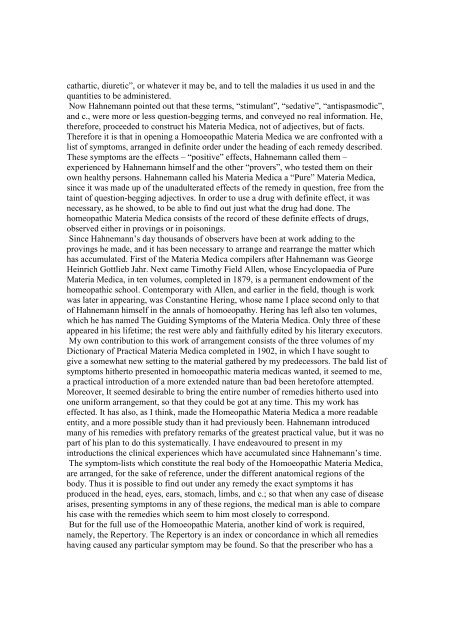CLARKE JH, Homoeopathy Explained - Classical Homeopathy Online
CLARKE JH, Homoeopathy Explained - Classical Homeopathy Online
CLARKE JH, Homoeopathy Explained - Classical Homeopathy Online
You also want an ePaper? Increase the reach of your titles
YUMPU automatically turns print PDFs into web optimized ePapers that Google loves.
cathartic, diuretic”, or whatever it may be, and to tell the maladies it us used in and the<br />
quantities to be administered.<br />
Now Hahnemann pointed out that these terms, “stimulant”, “sedative”, “antispasmodic”,<br />
and c., were more or less question-begging terms, and conveyed no real information. He,<br />
therefore, proceeded to construct his Materia Medica, not of adjectives, but of facts.<br />
Therefore it is that in opening a Homoeopathic Materia Medica we are confronted with a<br />
list of symptoms, arranged in definite order under the heading of each remedy described.<br />
These symptoms are the effects – “positive” effects, Hahnemann called them –<br />
experienced by Hahnemann himself and the other “provers”, who tested them on their<br />
own healthy persons. Hahnemann called his Materia Medica a “Pure” Materia Medica,<br />
since it was made up of the unadulterated effects of the remedy in question, free from the<br />
taint of question-begging adjectives. In order to use a drug with definite effect, it was<br />
necessary, as he showed, to be able to find out just what the drug had done. The<br />
homeopathic Materia Medica consists of the record of these definite effects of drugs,<br />
observed either in provings or in poisonings.<br />
Since Hahnemann’s day thousands of observers have been at work adding to the<br />
provings he made, and it has been necessary to arrange and rearrange the matter which<br />
has accumulated. First of the Materia Medica compilers after Hahnemann was George<br />
Heinrich Gottlieb Jahr. Next came Timothy Field Allen, whose Encyclopaedia of Pure<br />
Materia Medica, in ten volumes, completed in 1879, is a permanent endowment of the<br />
homeopathic school. Contemporary with Allen, and earlier in the field, though is work<br />
was later in appearing, was Constantine Hering, whose name I place second only to that<br />
of Hahnemann himself in the annals of homoeopathy. Hering has left also ten volumes,<br />
which he has named The Guiding Symptoms of the Materia Medica. Only three of these<br />
appeared in his lifetime; the rest were ably and faithfully edited by his literary executors.<br />
My own contribution to this work of arrangement consists of the three volumes of my<br />
Dictionary of Practical Materia Medica completed in 1902, in which I have sought to<br />
give a somewhat new setting to the material gathered by my predecessors. The bald list of<br />
symptoms hitherto presented in homoeopathic materia medicas wanted, it seemed to me,<br />
a practical introduction of a more extended nature than bad been heretofore attempted.<br />
Moreover, It seemed desirable to bring the entire number of remedies hitherto used into<br />
one uniform arrangement, so that they could be got at any time. This my work has<br />
effected. It has also, as I think, made the Homeopathic Materia Medica a more readable<br />
entity, and a more possible study than it had previously been. Hahnemann introduced<br />
many of his remedies with prefatory remarks of the greatest practical value, but it was no<br />
part of his plan to do this systematically. I have endeavoured to present in my<br />
introductions the clinical experiences which have accumulated since Hahnemann’s time.<br />
The symptom-lists which constitute the real body of the Homoeopathic Materia Medica,<br />
are arranged, for the sake of reference, under the different anatomical regions of the<br />
body. Thus it is possible to find out under any remedy the exact symptoms it has<br />
produced in the head, eyes, ears, stomach, limbs, and c.; so that when any case of disease<br />
arises, presenting symptoms in any of these regions, the medical man is able to compare<br />
his case with the remedies which seem to him most closely to correspond.<br />
But for the full use of the Homoeopathic Materia, another kind of work is required,<br />
namely, the Repertory. The Repertory is an index or concordance in which all remedies<br />
having caused any particular symptom may be found. So that the prescriber who has a
















